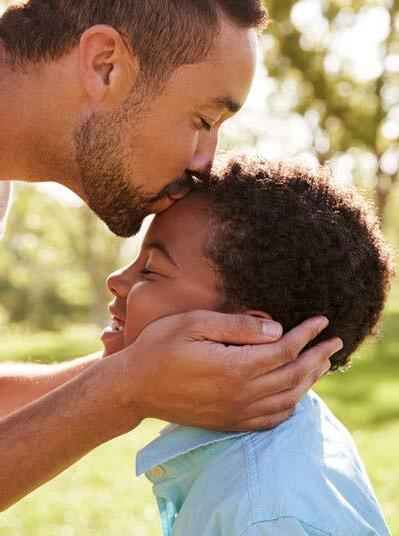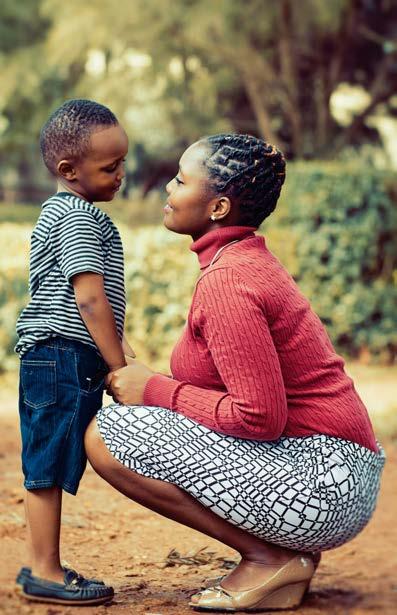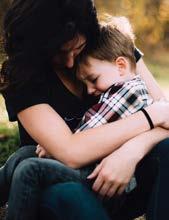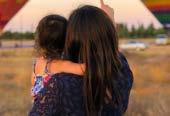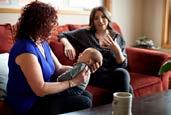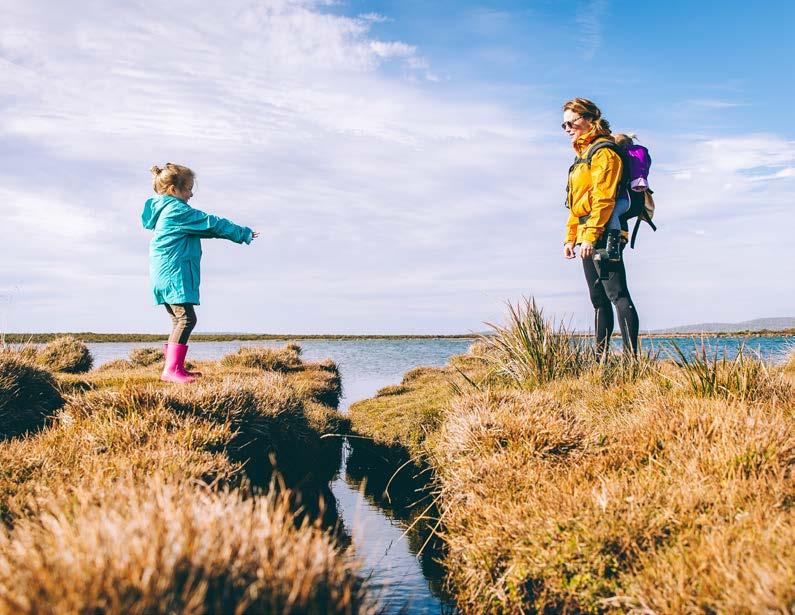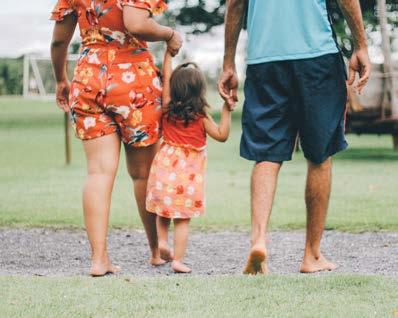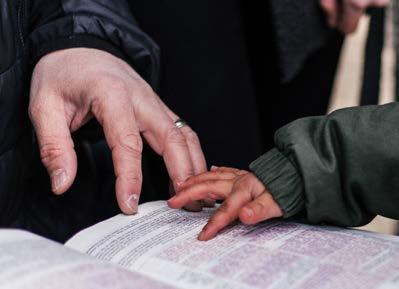CONCLUSIÓN
Para los niños que han sido separados del cuidado de sus padres, el panorama es especialmente difícil. Por definición, carecen de la protección natural que proviene de los padres en familias saludables. Afortunadamente, la investigación sugiere que las relaciones protectoras de apego pueden construirse después de la separación del cuidado de los padres, ya sea con los padres biológicos o con padres de familias alternativas por medio familia extensa, la adopción, o familias de acogimiento. Aunque las relaciones son complejas, vemos que elementos simples y claves, como el servicio y el retorno y el estado de consciencia plena del cuidador, pueden empezar a marcar la diferencia en la salud de la relación niño-cuidador.
Para poder apoyar el desarrollo apropiado y el bienestar de los niños, nosotros debemos centrarnos tanto en limitar las experiencias adversas de la infancia como en desarrollar su capacidad para superar los obstáculos. Ambos son importantes para mejorar los resultados para los niños sin importar su edad. Mientras que las dificultades del pasado de un niño no pueden ser borradas, nunca es demasiado tarde, y todavía hay la esperanza de un futuro brillante.
62 63
15 Johnson, S. B., Riley, A. W., Granger, D. A., & Riis, J. (2013). The science of early life toxic stress for pediatric practice and advocacy. Pediatrics, 131(2), 319–327. doi:10.1542/peds.2012-0469
16 Garner, A. S., Shonkoff, J. P., Siegel, B. S., Dobbins, M. I., Earls, M. F., Garner, A. S., … Wood, D. L. (2011). Early childhood adversity, toxic stress, and the role of the pediatrician: Translating developmental science into lifelong health. Pediatrics, 129(1). doi: 10.1542/peds.2011-2662 17 Shonkoff JP, Boyce WT, McEwen BS. Neuroscience, molecular biology, and the childhood roots of health disparities: Building a new framework for health promotion and disease prevention. JAMA. 2009;301(21):2252–2259. doi:https://doi.org/10.1001/jama.2009.754
18Fisher, P. A., Gunnar, M. R., Dozier, M., Bruce, J., & Pears, K. C. (2006). Effects of therapeutic interventions for foster children on behavioral problems, caregiver attachment, and stress regulatory neural systems. Annals of the New York Academy of Sciences, 1094(1), 215–225. doi: 10.1196/annals.1376.023
19 Allison Schroeder, Natalie Slopen & Mona Mittal (2018) Accumulation, timing, and duration of early childhood adversity and behavior problems at age 9, Journal of Clinical Child & Adolescent Psychology, doi:10.1080/15374416.2018.1496440
20 Hertzman C. (2013). The significance of early childhood adversity. Paediatrics & child health, 18(3), 127–128. doi:10.1093/pch/18.3.127 21Felitti, V. J., Anda, R. F., Nordenberg, D., Williamson, D. F., Spitz, A. M., Edwards, V., … Marks, J. S. (1998). Relationship of childhood abuse and household dysfunction to many of the leading causes of death in adults. American Journal of Preventive Medicine, 14(4), 245–258. doi: 10.1016/ s0749-3797(98)00017-
22 Hughes, K., Bellis, M. A., Hardcastle, K. A., Sethi, D., Butchart, A., Mikton, C., ... & Dunne, M. P. (2017). The effect of multiple adverse childhood experiences on health: a systematic review and meta-analysis. The Lancet Public Health, 2(8), e356-e366.
23 Starecheski, L. (2015). Take the ACE Quiz- And learn what it does and doesn’t mean. National Public Radio. Retrieved from: https:// www.npr.org/sections/healthshots/2015/03/02/387007941/take-the-ace-quiz-and-learn-what-it-does-and-doesntmean
24 Felitti, V. J., Anda, R. F., Nordenberg, D., Williamson, D. F., Spitz, A. M., Edwards, V., … Marks, J. S. (1998). Relationship of childhood abuse and household dysfunction to many of the leading causes of death in adults. American Journal of Preventive Medicine, 14(4), 245–258. doi: 10.1016/ s0749-3797(98)00017-
25 Brown, D.W., Anda, R.F., Tiemeier, H., Felitti, V.J., Edwards, V.J., Croft, J.B., Giles, W.H. (2009). Adverse childhood experiences and the risk of premature mortality. American Journal of Preventive Medicine, 37(5) 389-396.
26 Mehta, M. A., Golembo, N. I., Nosarti, C., Colvert, E., Mota, A., Williams, S. C., . . Sonuga-Barke, E. J. (2009, August). Amygdala, hippocampal and corpus callosum size following severe early institutional deprivation: The English and Romanian Adoptees study pilot. Retrieved from https://www. ncbi.nlm.nih.gov/pubmed/19457047
27 Tottenham, N., Hare, T. A., Quinn, B. T., McCarry, T. W., Nurse, M., Gilhooly, T., . Casey, B. J. (2010, January 01). Prolonged institutional rearing is associated with atypically large amygdala volume and difficulties in emotion regulation. Retrieved from https://www.ncbi. nlm.nih.gov/ pubmed/20121862
28 Gee, D. G., Gabard-Durnam, L. J., Flannery, J., Goff, B., Humphreys, K. L., Telzer, E. H., . . Tottenham, N. (2013, September 05). Early developmental emergence of human amygdala–prefrontal connectivity after maternal deprivation. Retrieved from https://www.pnas. org/content/ early/2013/09/04/1307893110.short
29 Ha, Thao., Granger A., Douglas. (2016). Family relations, stress, and vulnerability: Biobehavioral implications for prevention and practice. Interdisciplinary Journal of Applied Family Studies, 65, 9-23
30 McEwen, B. S. (2000). The neurobiology of stress: From serendipity to clinical relevance. Brain Research, 886, 172 – 189.
31Tronick, E. Z., & Gianino, A. (1986). Interactive mismatch and repair: Challenges to the coping infant. Zero to Three, 6(3), 1-6.
32Perez, C. M., & Widom, C. (1994). Childhood victimization and long-term intellectual and academic outcomes. Child Abuse & Neglect, 18(8), 617-633.
33Barry, R. J., Clarke, A. R., & Johnstone, S. J. (2003). A review of electrophysiology in attention-deficit/ hyperactivity disorder: I. Qualitative and quantitative electroencephalography. Clinical Neurophysiology, 114(2), 171-183.
34 Edmiston, E., Wang, F., Mazure, C., Guiney, J., Sinha, R., Mayes, L., & Blumberg, H. (2011). Corticostriatal limbic gray matter morphology in adolescents with self-reported exposure to childhood maltreatment. Archives of Pediatric and Adolescent Medicine, 165(12), 1069- 1077
35 Sherr, L., Roberts, K. J., & Gandhi, N. (2017). Child violence experiences in institutionalised/orphanage care. Psychology, Health & Medicine, 22(sup1), 31-57.
36 Chapman, D. P., Whitfield, C. L., Felitti, V. J., Dube, S. R., Edwards, V. J., Anda, R. F. (2004). Adverse childhood experiences and the risk of depressive disorders in adulthood. Journal of Affective Disorders. 217- 225.
37 Pears, K. C., Kim, H. K., Buchanan, R., & Fisher, P. A. (2015). Adverse consequences of school mobility for children in foster care: A prospective longitudinal study. Child development, 86(4), 1210-1226.
38 Herzog, J. I., & Schmahl, C. (2018). Adverse childhood experiences and the consequences on neurobiological, psychosocial, and somatic conditions across the lifespan. Frontiers in Psychiatry, 9. doi: 10.3389/fpsyt.2018.00420
39 Council, N. S. (2014). Excessive stress disrupts the development of brain architecture. Journal of Children’s Services, 9(2), 143–153. doi: 10.1108/jcs-01-2014-0006
40 Toxic Stress. (n.d.). Retrieved from https://developingchild.harvard.edu/science/key-concepts/toxic-stress/.
41Dobrova-Krol, N. A., van IJzendoorn, M. H., Bakermans-Kranenburg, M. J., Cyr, C., & Juffer, F. (2008). Physical growth delays and stress dysregulation in stunted and non-stunted Ukrainian institution-reared children. Infant Behavior and Development, 31(3), 539-553.
42Dozier, M., Manni, M., Gordon, M. K., Peloso, E., Gunnar, M. R., Stovall-McClough, K. C., .. . Levine, S. (2006). Foster children’s diurnal production of cortisol: An exploratory study. Child maltreatment, 11(2), 189-197.
43 Gunnar, M. R., Morison, S. J., Chisholm, K., & Schuder, M. (2001). Salivary cortisol levels in children adopted from Romanian orphanages. Development and Psychopathology, 13(3), 611-628.
44Ladd, C. O., Huot, R. L., Thrivikraman, K., Nemeroff, C. B., Meaney, M. J., & Plotsky, P. M. (2000). Long-term behavioral and neuroendocrine adaptations to adverse early experience. The Biological Basis for Mind Body Interactions Progress in Brain Research, 81–103. doi: 10.1016/s0079-6123(08)62132-9
45 Harvard Health Publishing. (2011). Understanding the stress response: Chronic activation of this survival mechanism impairs health. Retrieved from https://www.health.harvard. edu/stayinghealthy/understanding-the-stress-response
46 Anda, R. F., Croft, J. B., Felitti, V. J., Nordenberg, D., Giles, W. H., Williamson, D. F., & Giovino, G. A. (1999). Adverse childhood experiences and smoking during adolescence and adulthood. Jama, 282(17), 1652-1658.
47 Anda, R. F., Felitti, V. J., Bremner, J. D., Walker, J. D., Whitfield, C. H., Perry, B. D., ... & Giles, W. H. (2006). The enduring effects of abuse and related adverse experiences in childhood. European archives of psychiatry and clinical neuroscience, 256(3), 174-186.
48 Herrman H, Stewart DE, DiazGranados N, Berger EL, Jackson B, Yuen T. What is resilience? Can J Psychiatry. 2011;56(5):258---265.
49 Richaud, M. C. (2013). Contributions to the study and promotion of resilience in socially vulnerable children. American Psychologist, 68(8), 751-758. doi:10.1037/a0034327
50 Wijngaards-de Meij, L., Stroebe, M., Schut, H., Stroebe, W., van den Bout, J., van der Heijden, P. G. M., & Dijkstra, I. (2007). Patterns of attachment and parents’ adjustment to the death of their child. Personality and Social Psychology Bulletin, 33, 537–548.
51Black-Hughes, C., & Stacy, P. D. (2013). Early childhood attachment and its impact on later life resilience: A comparison of resilient and nonresilient female siblings. Journal of Evidence-Based Social Work, 10, 410–420. doi:10.1080/15433714.2012.759456
52 Foster, K.A. (2012). In search of regional resilience. In M. Weir, N. Pindus, H. Wial, & H. Wolman (Eds.) Urban and Regional Policy and Its Effects:
Building Resilient Regions, Volume 4 (pp. 24–59). Washington, D.C.: Brookings Institution Press.
53 Rutter, M. (1985). Resilience in the face of adversity: Protective factors and resistance to psychiatric disorder. British Journal of Psychiatry, 147, 598–611. doi: 10.1192/bjp.147.6.598
54 Holz, N. E., Tost, H., & Meyer-Lindenberg, A. (2019). Resilience and the brain: A key role for regulatory circuits linked to social stress and support. Molecular Psychiatry. doi: 10.1038/s41380-019-0551-9
55 Herta, D.- C., Brindas, P., Trifu, R., & Cozman, D. (2016). Risk and resilience factors of persons exposed to accidents. Medicine and Pharmacy Reports, 89(2), 257–266. doi: 10.15386/cjmed-547
56Fritz, J., Stochl, J., Fried, E. I., Goodyer, I., Borkulo, C. V., Wilkinson, P. O., & Harmelen, A.-L. V. (2019). Unravelling the complex nature of resilience factors and their changes between early and later adolescence. BMC Medicine, 17(203). doi: 10.31219/osf.io/8xgkb
57 Bonanno, G. A. (2004). Loss, trauma, and human resilience: Have we underestimated the human capacity to thrive after extremely aversive events? American psychologist, 59(1), 20.
58 American Psychological Association. (2011). The road to resilience. http://www.apa.org/helpcenter/road-resilience
59Seery, M. D. (2011). Resilience: A silver lining to experiencing adverse life events?. Current Directions in Psychological Science, 20(6), 390-394. 60Luthar, S.S., & Brown, P.J. (2007). Maximizing resilience through diverse levels of inquiry: Prevailing paradigms, possibilities, and priorities for the future. Development and Psychopathology, 19(3), 931–955.
61 Daskalakis, N. P., Bagot, R. C., Parker, K. J., Vinkers, C. H., & Kloet, E. D. (2013). The three-hit concept of vulnerability and resilience: Toward understanding adaptation to early-life adversity outcome. Psychoneuroendocrinology, 38(9), 1858–1873. doi: 10.1016/j.psyneuen. 2013.06.008
62Bowes, L., & Jaffee, S. R. (2013). Biology, genes, and resilience: toward a multidisciplinary approach. Trauma, Violence, & Abuse, 14(3), 195– 208. doi: 10.1177/1524838013487807
63Davidson, R.J., & McEwen, B.S. (2012). Social influences on neuroplasticity: Stress and interventions to promote well-being. Nature Neuroscience, 15(5), 689–695.
64 Domhardt, M., Münzer, A., Fegert, J. M., & Goldbeck, L. (2015). Resilience in survivors of child sexual abuse: A systematic review of the literature. Trauma, Violence, & Abuse, 16(4), 476-493.
65 Yeager, D. S., & Dweck, C. S. (2012). Mindsets that promote resilience: When students believe that personal characteristics can be developed. Educational Psychologist, 47, 302–314. doi: 10.1080/00461520.2012.722805
66 Ungar, M. (Ed.) (2012). The Social Ecology of Resilience: A Handbook of Theory and Practice. New York, NY: Springer.
67 Masten, A.S. (2014). Global perspectives on resilience in children and youth. Child Development, 85(1), 6–20.
68 Alvord, M. K., & Grados, J. J. (2005). Enhancing Resilience in Children: A Proactive Approach. Professional Psychology: Research and Practice, 36(3), 238-245. doi:10.1037/0735-7028.36.3.238
69 Iacoviello B. M., Charney D. S. (2014).Psychosocial facets of resilience: implications for preventing posttrauma psychopathology, treating trauma survivors, and enhancing community resilience. Eur J Psychotraumatology 1(5). doi: 10.3402/ejpt.v5.23970.
70Sasser, J., Duprey, E. B., & Oshri, A. (2019). A longitudinal investigation of protective factors for bereaved maltreated youth. Child Abuse & Neglect, 96, 104135. doi: 10.1016/j.chiabu.2019.104135
71 Holmes, J. (2017). Roots and routes to resilience and its role in psychotherapy: a selective, attachment-informed review. Attachment & Human Development, 19(4), 364–381. doi: 10.1080/14616734.2017.1306087
72 Van IJzendoorn, M.H., Palacios, J., Sonuga-Barke, E.J.S., Gunnar, M.R., Vorria, P., McCall, R.B., LeMare, L., Bakermans-Kranenburg, M.J., DobrovaKrol, N.A., Juffer, F. (2011). Children in institutional care: Delayed development and resilience. Monographs of the Society for Research in Child Development, 76(4), 8-30.
73Kasen S., Wickramaratne P., Gameroff M.J., & Weissman M.M. (2012). Religiosity and resilience in persons at high risk for major depression. Psychological Medicine, 42(3), 509–519.
74Gilligan, R. (2000). Adversity, resilience and young people: the protective value of positive school and spare time experiences. Children & Society, 14(1), 37–47. doi: 10.1002/(sici)1099-0860(200002)14:1<37::aid-chi564>3.3.co;2-n
75Gilligan, R. (1999). Enhancing the resilience of children and young people in public care by mentoring their talents and interests. Child Family Social Work, 4(3), 187–196. doi: 10.1046/j.1365-2206.1999.00121.x
76 Crane, M. F., Searle, B. J., Kangas, M., & Nwiran, Y. (2019). How resilience is strengthened by exposure to stressors: the systematic self-reflection model of resiliencea strengthening. Anxiety, Stress, & Coping, 32(1), 1-17.
77 Infurna, F. J., & Luthar, S. S. (2018). Re-evaluating the notion that resilience is commonplace: A review and distillation of directions for future research, practice, and policy. Clinical Psychology Review, 65, 43-56.
78Brody, G. H., Yu, T., & Beach, S. R. H. (2016). Resilience to adversity and the early origins of disease. Development and Psychopathology, 28(4), 1347–1365. doi: 10.1017/s0954579416000894
79 Steele, H., Bate, J., Steele, M., Dube, S. R., Danskin, K., Knafo, H., ... & Murphy, A. (2016). Adverse childhood experiences, poverty, and parenting stress. Canadian Journal of Behavioural Science/Revue canadienne des sciences du comportement, 48(1), 32.
80 Simeon, D., Yehuda, R., Cunill, R., Knutelska, M., Putnam, F. W., & Smith, L. M. (2007). Factors associated with resilience in healthy adults. Psychoneuroendocrinology, 32, 1149–1152. doi:10.1016/j.psyneuen.2007.08.005
81 Van IJzendoorn, M.H. & Juffer, F. (2006). The Emanuel Miller Memorial Lecture 2006: Adoption as intervention. Meta-analytic evidence for massive catch-up and plasticity in physical, socio-emotional, and cognitive development. Journal of Child Psychology and Psychiatry, 47, 1228-1245. doi:10.1111/j.1469-7610.2006.01675.x
82 Van IJzendoorn, M.H., Bakermans-Kranenburg, M.J., Duschinsky, R., Goldman, P.S., Fox, N.A., Gunnar, M.R., Johnson, D.E., Nelson, C.A., Reijman, S., Skinner, G.C.M., Zeanah, C.H., & Sonuga-Barke, E.J.S. (2020, in press). Institutionalisation and deinstitutionalisation of children I: A systematic and integrative review of evidence regarding effects on development. The Lancet Psychiatry.
83 Fisher, P. A. (2015). Adoption, fostering, and the needs of looked-after and adopted children. Child and Adolescent Mental Health, 20(1), 5-12
84 DeGarmo, D.S., & Forgatch, M.S. (1999). Contexts as predictors of changing maternal parenting practices in diverse family structures: A social interactional perspective of risk and resilience. In E.M. Hetherington (Ed.), Coping with divorce, single parenting, and remarriage: A risk and resiliency perspective (pp. 227–252). Mahwah, NJ: Lawrence Erlbaum.
85 Flores, E., Cicchetti, D., & Rogosch, F.A. (2005). Predictors of resilience in maltreated and nonmaltreated Latino children. Developmental Psychology, 41, 338–351.
86 Blaustein, M. E., & Kinniburgh, K. M. (2018). Treating traumatic stress in children and adolescents: How to foster resilience through attachment, self-regulation, and competency. Guilford Publications.
87Flannery, J. E., Beauchamp, K. G., & Fisher, P. A. (2016). The role of social buffering on chronic disruptions in quality of care: evidence from caregiver-based interventions in foster children. Social Neuroscience, 12(1), 86–91. doi: 10.1080/17470919.2016.1170725
88 Bowlby, J. (1969). Attachment and Loss, Vol. 1: Attachment. Attachment and Loss. New York: Basic Books. [See page 194].
89 De Wolff, M. & Van IJzendoorn, M.H. (1997). Sensitivity and attachment. A meta-analysis on parental antecedents of infant attachment. Child Development, 68, 571-591.
90 Bowlby, J. (1958). The nature of the child's tie to his mother. International Journal of Psycho-analysis, 39, 350-373.
91 Schore, A. N. (2000). Attachment and the regulation of the right brain. Attachment & Human Development, 2(1), 23-47.
92 Bowlby, J. (1973). Separation: Anxiety and Anger. New York: Basic Books.
93 Van IJzendoorn, M.H., & Sagi-Schwartz, A. (2008). Cross-Cultural patterns of attachment: Universal and contextual dimensions. In J. Cassidy,
64 65
& P.R. Shaver (Eds.), Handbook of attachment: Theory, research, and clinical applications (2nd ed.) (pp. 880-905). New York: Guilford Press.
94 Van Ijzendoorn, M. H., & Kroonenberg, P. M. (1988). Cross-cultural patterns of attachment: A meta-analysis of the strange situation. Child Development, 59, 147-156.
95 Bretherton, I., & Munholland, K.A. (1999). Internal working models revisited. In J. Cassidy & P.R. Shaver (Eds.), Handbook of attachment: Theory, research, and clinical applications (pp. 89– 111). New York: Guilford Press.
96 De Ruiter, C., & Van Ijzendoorn, M. H. (1993). Attachment and cognition: A review of the literature. International Journal of Educational Research, 19, 525-525.
97 Fearon, R.M.P., Bakermans-Kranenburg, M.J., Van IJzendoorn, M.H., Lapsley, A., & Roisman, G.I. (2010). The significance of insecure attachment and disorganization in the development of children’s externalizing behavior: A meta-analytic study. Child Development, 81, 435-456.
98 Groh, A. M., Fearon, R. M. P., van IJzendoorn, M. H., Bakermans-Kranenburg, M. J. & Roisman, G. I. (2017). Attachment in the Early Life Course: Meta-Analytic Evidence for Its Role in Socioemotional Development. Child Development Perspectives 11(1), 70-6.
99 Van Londen, W.M., Juffer, F., & Van IJzendoorn, M.H. (2007). Attachment, cognitive and motor development in adopted children: Short-term outcomes after international adoption. Journal of Pediatric Psychology, 32, 1259-1263.
100 Bakermans-Kranenburg, M. J. & van IJzendoorn, M. H. (2016). Attachment, Parenting, and Genetics. In J. Cassidy and P. R. Shaver (Eds.), Handbook of Attachment, 3rd Edition (pp. 155-179). Guilford Press.
101 Ainsworth, M. D. S. (1978). Patterns of attachment: A psychological study of the strange situation. Hillsdale, NJ/New York, NY: Lawrence Erlbaum Associates.
102 Fraley, R. C., & Waller, N. G. (1998). Adult attachment patterns: A test of the typological model. In J. A. Simpson & W. S. Rholes (Eds.), Attachment theory and close relationships (p. 77–114). Guilford Press.
103 Fraley, R. C., & Shaver, P. R. (2000). Adult romantic attachment: Theoretical developments, emerging controversies, and unanswered
104 Cassidy, J., Jones, J. D., & Shaver, P. R. (2013). Contributions of attachment theory and research: A framework for future research,
105 Cassidy, J. (2001). Truth, lies, and intimacy: An attachment perspective. Attachment & Human Development, 3(2), 121-155.
106 Sroufe, L. A. (2005). Attachment and development: A prospective, longitudinal study from birth to adulthood. Attachment & Human Development, 7(4), 349-367.
107 Gander, M., & Buchheim, A. (2015). Attachment classification, psychophysiology and frontal EEG asymmetry across the lifespan: a review. Frontiers in Human Neuroscience, 9, 79.
108 Main, M. & Solomon, J. (1986). Discovery of an insecure-disorganized/ disoriented attachment pattern. In Affective Development in Infancy, ed.
T. B. Brazelton and M. W. Yogman, pp. 95-124. Norwood, NJ: Ablex.
109 Duschinsky, R. (2015). The emergence of the disorganized/disoriented (D) attachment classification, 1979–1982. History of Psychology, 18(1),
32.
110 Reisz, S., Duschinsky, R., & Siegel, D. J. (2018). Disorganized attachment and defense: exploring John Bowlby’s unpublished reflections. Attachment & Human Development, 20(2), 107-134.
111 Carlson, E. A. (1998). A prospective longitudinal study of attachment disorganization/disorientation. Child Development, 69(4), 1107-1128.
112 Van IJzendoorn, M.H., Bakermans-Kranenburg, M.J., Duschinsky, R., Goldman, P.S., Fox, N.A., Gunnar, M.R., Johnson, D.E., Nelson, C.A., Reijman, S., Skinner, G.C.M., Zeanah, C.H., & Sonuga-Barke, E.J.S. (2020, in press). Institutionalisation and deinstitutionalisation of children I: A systematic and integrative review of evidence regarding effects on development. The Lancet Psychiatry.
113 Cyr, C., Euser, E. M., Bakermans-Kranenburg, M. J., & Van Ijzendoorn, M. H. (2010). Attachment security and disorganization in maltreating
114 O'Conner, T. G., & Zeanah, C. H. (2003). Attachment disorders: Assessment strategies and treatment approaches. Attachment & Human Development, 5(3), 223-244.
115 Rutter, M., Kim-Cohen, J., & Maughan, B. (2006). Continuities and discontinuities in psychopathology between childhood and adult life. Journal of Child Psychology and Psychiatry,47, 276–295.
116 Murphy, A., Steele, M., Dube, S. R., Bate, J., Bonuck, K., Meissner,P.,...Steele, H. (2014). Adverse childhood experiences questionnaire and adult attachment interview: Implications for parentchild relationships.Child Abuse & Neglect,38, 224–233.
117 Granqvist, P., Sroufe, L. A., Dozier, M., Hesse, E., Steele, M., van Ijzendoorn, M., Solomon, J., Schuengel, C., Fearon, P., Bakermans- Kranenburg, M., Steele, H., Cassidy, J., Carlson, E., Madigan, S., Jacobvitz, D., Foster, S., Behrens, K., Rifkin-Graboi, A., Gribneau, N., D., Weigand, R., Siegel, D., Dazzi, N., Bernard, K., Fonagy, P., Waters, E., Toth, S., Cicchetti, D., Zeanah, C. H., Lyons-Ruth, K., Main, M. & Duschinsky, R. (2017). Disorganized attachment in infancy: a review of the phenomenon and its implications for clinicians and policy-makers. Attachment & Human Development, 1-25.
118 Grady, M. D., Levenson, J. S., & Bolder, T. (2017). Linking adverse childhood effects and attachment: A theory of etiology for sexual offending. Trauma, Violence, & Abuse, 18(4), 433–444. https://doi.org/10.1177/1524838015627147
119 [For more information see Masten, A. S., & Cicchetti, D. (2010). Developmental cascades [Editorial]. Development and Psychopathology, 22(3), 491–495.
120 yr, C., Euser, E. M., Bakermans-Kranenburg, M. J., & Van Ijzendoorn, M. H. (2010). Attachment security and disorganization in maltreating and high-risk families: A series of meta-analyses. Development and psychopathology, 22(1), 87-108.
121 Morton, N. & Browne, K. D. (1998). Theory and observation of attachment and its relation to child maltreatment: A review. Child Abuse & Neglect, 22, 1093–1104.
122 Rutter, M., & Sroufe, L. (2000). Developmental psychopathology:Concepts and challenges.Development and Psychopathology,12,265–296.
123 Ford, J. D., Chapman, J., Connor, D. F., & Cruise, K. R. (2012).Complex trauma and aggression in secure juvenile justice settings.Criminal Justice and Behavior, 39, 694–72
124Ferrara, P., Cutrona, C., Guadagno, C., Amodeo, M. E., Del-Vescovo, E., Ianniello, F., & Petitti, T. (2018). Changes in trajectories of physical growth in a domestic adoptees sample: A preliminary study. The Turkish Journal of Pediatrics, 60(4), 464. doi: 10.24953/turkjped.2018.04.021
125Wade, M., Fox, N. A., Zeanah, C. H., & Nelson, C. A. (2019). Long-term effects of institutional rearing, foster care, and brain activity on memory and executive functioning. Proceedings of the National Academy of Sciences, 116(5), 1808–1813. doi: 10.1073/pnas.1809145116
126 Van IJzendoorn, M.H., Bakermans-Kranenburg, M.J., Duschinsky, R. & Skinner, G.C.M. (2019). Legislation in search of ‘good-enough’ care arrangements for the child: A quest for continuity of care. Jim G. Dwyer (Editor): The Oxford Handbook of Children and the Law. Oxford University Press. DOI: 10.1093/oxfordhb/9780190694395.013.5
127 Schneider, K. M., & Phares, V. (2005). Coping with parental loss because of termination of parental rights. Child Welfare, 84(6), 819.
128 Van IJzendoorn, M.H., Bakermans-Kranenburg, M.J., Duschinsky, R. & Skinner, G.C.M. (2019). Legislation in search of ‘good-enough’ care arrangements for the child: A quest for continuity of care. Jim G. Dwyer (Editor): The Oxford Handbook of Children and the Law. Oxford University Press. DOI: 10.1093/oaxfordhb/9780190694395.013.5
129Juffer, F., & Bakermans-Kranenbu Discipline (VIPP-SD): A case study. Journal of Clinical Psychology, 74(8), 1346–1357. doi: 10.1002/jclp.22645
130 Dozier M, Roben CKP, Caron E, Hoye J, Bernard K. (2018). Attachment and Biobehavioral Catch-up: An evidence-based intervention for rg, M. J. (2018). Working with Video-feedback Intervention to promote Positive Parenting and Sensitive vulnerable infants and their families. Psychother Res.28(1):18-29.
131Murphy, A., Steele, H., Bate, J., Nikitiades, A., Allman, B., Bonuck, K., … Steele, M. (2015). Group Attachment-Based Intervention: . Family & Community Health, 38(3), 268–279. doi: 10.1097/fch.0000000000000074
132 Van Den Dries, L., Juffer, F., Van IJzendoorn, M. H., & Bakermans-Kranenburg, M. J. (2009). Fostering security? A meta-analysis of 133 Martin, F. S., & Zulaika, G. (2016). Who Cares for Children? A Descriptive Study of Care-Related Data Available Through Global Household
Surveys and How These Could Be Better Mined to Inform Policies and Services to Strengthen Family Care. Global Social Welfare,3(2), 6. 134Moretti, M. M., & Obsuth, I. (2009). Effectiveness of an attachment-focused manualized intervention for parents of teens at risk for aggressive behaviour: The Connect Program. Journal of Adolescence, 32(6), 1347–1357. doi: 10.1016/j.adolescence.2009.07.013
135Purvis, K. B., Cross, D. R., Dansereau, D. F., & Parris, S. R. (2013). Trust-Based Relational Intervention (TBRI): A Systemic Approach to Complex Developmental Trauma. Child & Youth Services, 34(4), 360–386. doi: 10.1080/0145935x.2013.859906
136 Triseliotis, J. (2002). Long-term foster care or adoption? The evidence examined. Child and Family Social Work, 7, 23-33.
137 Schofield, G., & Beek, M. (2005). Providing a secure base: Parenting children in long-term foster family care. Attachment & human development, 7(1), 3-26.
138Fisher, P. A., Frenkel, T. I., Noll, L. K., Berry, M., & Yockelson, M. (2016). Promoting Healthy Child Development via a Two-Generation Translational Neuroscience Framework: The Filming Interactions to Nurture Development Video Coaching Program. Child Development Perspectives, 10(4), 251–256. doi: 10.1111/cdep.12195
139 Dozier, M., Kaufman, J., Kobak, R., O'Connor, T. G., Sagi-Schwartz, A., Scott, S., ... & Zeanah, C. H. (2014). Consensus statement on group care for children and adolescents: A statement of policy of the American Orthopsychiatric Association. American Journal of Orthopsychiatry, 84(3), 219. 140Lewis, E. E., Dozier, M., Ackerman, J., & Sepulveda-Kozakowski, S. (2007). The effect of placement instability on adopted children's inhibitory control abilities and oppositional behavior. Developmental Psychology, 43(6), 1415–1427. doi: 10.1037/0012-1649.43.6.1415
141Emily Gardiner, Grace Iarocci & Marlene Moretti (2017) Integrative care for adolescents with dual diagnosis: Considering trauma and attachment within an innovative model for clinical practice, Journal of Mental Health Research in Intellectual Disabilities, 10(4), 321-344, DOI: 10.1080/19315864.2017.1337835
142Steele, H., Steele, M., Bonuck, K., Meissner, P., & Murphy, A. (2018). Group attachment-based intervention: A multifamily trauma-informed intervention. In H. Steele & M. Steele (Eds.), Handbook of Attachment-based Interventions (p. 198–219). Guilford Press.
143Kinniburgh, K. J., Blaustein, M., & Spinnazola, J. (2005). ARC: Attachment, self-regulation, and competency: A comprehensive framework for intervention with complexly traumatized youth. PsycEXTRA Dataset, 35(5), 424–430. doi: 10.1037/e732542011-001
144 Chernego, D. I., McCall, R. B., Wanless, S. B., Groark, C. J., Vasilyeva, M. J., Palmov, O. I., … Muhamedrahimov, R. J. (2018). The Effect of a Social-Emotional Intervention on the Development of Preterm Infants in Institutions. Infants and young children, 31(1), 37–52. doi:10.1097/ IYC.0000000000000108
146 Egeland, B., & Sroufe, L. (1981). Attachment and early maltreatment. Child Development, 52(1), 44-52.
147Reynolds, A. M., & Burton, S. L. (2016). Serve and return: Communication foundations for early childhood music policy stakeholders. Arts Education Policy Review, 118(3), 140–153. doi: 10.1080/10632913.2016.1244779
148 Mundy, P., & Newell, L. (2007). Attention, joint attention, and social cognition. Current Directions in Psychological Science, 16(5), 269–274. doi:10.1111/j.1467-8721.2007.00518.x
149Parris, S. R., Dozier, M., Purvis, K. B., Whitney, C., Grisham, A., & Cross, D. R. (2014). Implementing Trust-Based Relational Intervention® in a charter school at a residential facility for at-risk youth. Contemporary School Psychology, 19(3), 157–164. doi: 10.1007/s40688-014-0033-7 150 Bakermans-Kranenburg, M.J., Juffer, F., & Van IJzendoorn, M.H. (2019). Reflections on the mirror: On video-feedback to promote positive parenting and infant mental health. In Ch.H. Zeanah (Ed.), Handbook of Infant Mental Health (4th edition), pp. 527-542. New York: Guilford Press.
151 Tosone, C., Minami, T., Bettmann, J. E., & Jasperson, R. A. (2010). New York City social workers after 9/11: Their attachment, resiliency, and compassion fatigue. International Journal of Emergency Mental Health, 12, 103–116.
66 67
